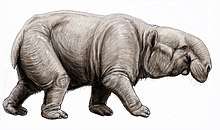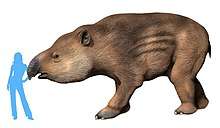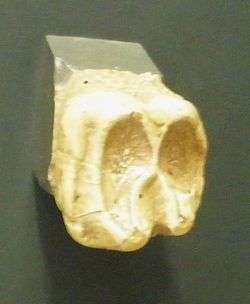Barytherium
Barytherium (meaning "heavy beast") is a genus of an extinct family (Barytheriidae) of primitive proboscideans that lived during the late Eocene and early Oligocene in North Africa. The Barytheriidae were the first large proboscideans to appear in the fossil records and were characterized by a strong sexual dimorphism. They were about 1.8–2.0 m tall at the shoulder and weighed about 2 tonnes.[1]


| Barytherium | |
|---|---|
 | |
| Barytherium molar | |
| Scientific classification | |
| Kingdom: | |
| Phylum: | |
| Class: | |
| Order: | |
| Suborder: | |
| Family: | C.W. Andrews, 1906 |
| Genus: | †Barytherium C.W. Andrews, 1901 |
| Species | |
| |
The type species is Barytherium grave, found at the beginning of the 20th century in Fayum, Egypt.[2] More complete specimens have been found since then, at Dor el Talha, Libya, and most recently at the Aidum area in Oman. In some respects, these animals would have looked similar to a modern Asian elephant, but with a more slender build. The most visible difference, however, would have been the tusks. Barytherium spp. had eight very short tusks, four each in the upper and lower jaws, which resembled those of a modern hippopotamus more than those of an elephant. The upper pairs were vertical, while the lower pairs projected forwards from the mouth horizontally. Together, these would have created a shearing action for cropping plants.[3]
Barytherium fossils were discovered in 2011 in the Aidum area in Dhofar by Oman's Ministry of Heritage and Culture and brought to Sultan Qaboos University (SQU) for identification. The team included Professor Sobhi Nasir and Dr. Abdulrahman al Harthy from SQU and Dr. Erick Seifert from Stony Brook University, New York. The scientists named the new finding Barytherium omansi.[4]
References
- Larramendi, A. (2016). "Shoulder height, body mass and shape of proboscideans" (PDF). Acta Palaeontologica Polonica. 61. doi:10.4202/app.00136.2014.
- Andrews, C.W. 1901. Über das Vorkommen von Proboscidiern in untertertiären Ablagerungen Aegyptens. Tageblatt des V Internationalen Zoologischen Kongresses, Berlin 6: 4–5.
- Savage, RJG & Long, MR (1986). Mammal Evolution: an illustrated guide. New York: Facts on File. p. 148. ISBN 0-8160-1194-X.
- "Bones of Elephant Ancestors Found" Archived August 5, 2011, at the Wayback Machine, The Omani Observer, May 22, 2011, retrieved May 22, 2011.